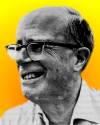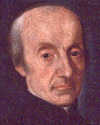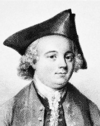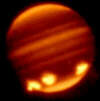
On 16 Jul 1910, David Lambert Lack was born, a British ornithologist and author of books popularizing natural science. Today's book pick is: Life of the Robin, by David Lack. This is an attractive and readable little book on the English robin, which is of a different genus from the red-breasted bird (of the thrush family) also called the robin in America. The English robin is about the size of a sparrow, and Lack has much to write about it, including its habits, song, fighting and territory. The male robin sings not only to please the female, but does so on its own territory, thus warning away intruders. If necessary the robin will defend its territory with a fight. Lack includes many well-chosen quotations from various centuries vividly illustrating the esteem with which the English people regard this, its perhaps best-known, bird. Ornithologists will find this is a wholly dependable scientific treatise, while laymen will find it wholly delightful and absorbing reading.
It is available from Amazon, typically about Used from $5.56. (As of earlier time of writing - subject to change.)
 | Let us suppose that we have laid on the table... [a] piece of glass... and let us homologize this glass to a whole order of plants or birds. Let us hit this glass a blow in such a manner as but to crack it up. The sectors circumscribed by cracks following the first blow may here be understood to represent families. Continuing, we may crack the glass into genera, species and subspecies to the point of finally having the upper right hand corner a piece about 4 inches square representing a sub-species. |
 | Rumour has it that the gardens of natural history museums are used for surreptitious burial of those intermediate forms between species which might disturb the orderly classifications of the taxonomist. |
 | The vacuum-apparatus requires that its manipulators constantly handle considerable amounts of mercury. Mercury is a strong poison, particularly dangerous because of its liquid form and noticeable volatility even at room temperature. Its poisonous character has been rather lost sight of during the present generation. My co-workers and myself found from personal experience-confirmed on many sides when published—that protracted stay in an atmosphere charged with only 1/100 of the amount of mercury required for its saturation, sufficed to induce chronic mercury poisoning. This first reveals itself as an affection of the nerves, causing headaches, numbness, mental lassitude, depression, and loss of memory; such are very disturbing to one engaged in intellectual occupations. |
| Before you look at today's web page, see if you can answer some of these questions about the events that happened on this day. Some of the names are very familiar. Others will likely stump you. Tickle your curiosity with these questions, then check your answers on today's web page. | |
| Births | |
 | Giuseppe Piazzi, born 16 Jul 1746, was an Italian astronomer and author who discovered the first of a new type of heavenly body (1801). Years later, when the thousandth of this type was discovered, it was named Piazzia in his honor. What was this type of heavenly body - and what is its name? |
 | John Kay, born 16 Jul 1704, was an English machinist and engineer, inventor of the flying shuttle power loom, patented 1733, which was an important step toward automatic weaving. A weaver using Kay's flying shuttle could produce much wider cloth at faster speeds than before. What is a flying shuttle? |
| Deaths | |
 | Josiah Spode (1755-1827) was an English potter who is generally recognised as the inventor of a new form of china. Before his invention, the English potters manufactured fine soft-paste porcelain. Spode mixed kaolin, feldspar, and bone ash to make a new paste that became standard from 1800. What is the name for this new form of china? |
| Events | |
 | On 16 Jul of a certain year, the first atomic bomb was exploded at Los Alamos, New Mexico. What was the year of this test? |
 | On 16 Jul 1969, the crew of Apollo XI blasted off from Cape Kennedy on the first manned mission to the surface of the moon. Can you name all three members of the crew? |
 | On 16 Jul 1994, the first of 21 asteroids, major fragments of a comet that had broken-up 2 years earlier, hit Jupiter, creating a 1200-mile wide fireball 600 miles high to the joy of astronomers awaiting the celestial fireworks. Can you name the comet? |
Fast answers for the previous newsletter for July 15: They live in oxygen-deficient environments and derive their energy by reducin g CO2 and oxidizing hydrogen, and releasing methane • pulsars • schizophrenica • pearl • the decade including the year 1954 • France.
 If you enjoy this newsletter, the website, or wish to offer encouragement or ideas, please send feedback by using your mail reader Reply button.
If you enjoy this newsletter, the website, or wish to offer encouragement or ideas, please send feedback by using your mail reader Reply button. Your click on a Facebook, StumbleUpon, or other social button on the site webpages is also a welcome sign of appreciation. Thank you for using them.
© This newsletter is copyright 2020 by todayinsci.com. Please respect the Webmaster's wishes and do not put copies online of the Newsletter — or any Today in Science History webpage. (If you already have done so, please remove them. Thank you.) Offline use in education is encouraged such as a printout on a bulletin board, or projected for classroom viewing. Online, descriptive links to our pages are welcomed, as these will provide a reader with the most recent revisions, additions and/or corrections of a webpage. For any other copyright questions, please contact the Webmaster by using your mail reader Reply button.
--
If you do not want to receive any more newsletters, Unsubscribe
To update your preferences and to unsubscribe visit this link
Executive Real Estate Business Class
-
"It was like a man with wings. It wasn't like anything you'd see on TV or in a monster movie." ...
About the publisher
Search This Blog
Blog Archive
-
▼
2021
(585)
-
▼
July
(50)
- Newsletter for Saturday 31 July.
- Newsletter for Friday 30 July.
- Power off and play this summer!
- Newsletter for Thursday 29 July.
- Newsletter for Wednesday 28 July.
- Newsletter for Tuesday 27 July.
- Newsletter for Monday 26 July.
- Newsletter for Sunday 25 July.
- Newsletter for Saturday 24 July.
- Newsletter for Friday 23 July.
- Newsletter for Thursday 22 July.
- Newsletter for Wednesday 21 July.
- Newsletter for Tuesday 20 July.
- Newsletter for Monday 19 July.
- The Machines That Built America Premieres Tonight
- Newsletter for Sunday 18 July.
- Newsletter for Saturday 17 July.
- Newsletter for Friday 16 July.
- Newsletter for Thursday 15 July.
- Newsletter for Wednesday 14 July.
- Newsletter for Tuesday 13 July.
- On This Day for July 12 - Geraldine Ferraro design...
- Newsletter for Monday 12 July.
- Inventing ‘The Machines That Built America’
- On This Day for July 11 - Duel between Aaron Burr ...
- Newsletter for Sunday 11 July.
- On This Day for July 10 - Telstar 1 launched, John...
- Newsletter for Saturday 10 July.
- On This Day for July 9 - Catherine the Great assum...
- Newsletter for Friday 9 July.
- New Season! Hope, Through History Podcast
- On This Day for July 8 - Vasco da Gama's first voy...
- Newsletter for Thursday 8 July.
- Ending soon: savings that pop! 🎆
- On This Day for July 7 - Hawaiian Islands annexed ...
- Newsletter for Wednesday 7 July.
- On This Day for July 6 - Anne Frank forced into hi...
- Newsletter for Tuesday 6 July.
- On This Day for July 5 - Israel's Law of Return pa...
- Newsletter for Monday 5 July.
- On This Day for July 4 - Declaration of Independen...
- Newsletter for Sunday 4 July.
- July 4th Sale at the HISTORY Store!
- On This Day for July 3 - Battle of Gettysburg ende...
- Newsletter for Saturday 3 July.
- On This Day for July 2 - Civil Rights Act signed, ...
- Newsletter for Friday 2 July.
- July 4th savings that pop!
- On This Day for July 1 - Dominion of Canada establ...
- Newsletter for Thursday 1 July.
-
▼
July
(50)
-
Blogroll
-
About
HistoryFact










0 comments:
Post a Comment